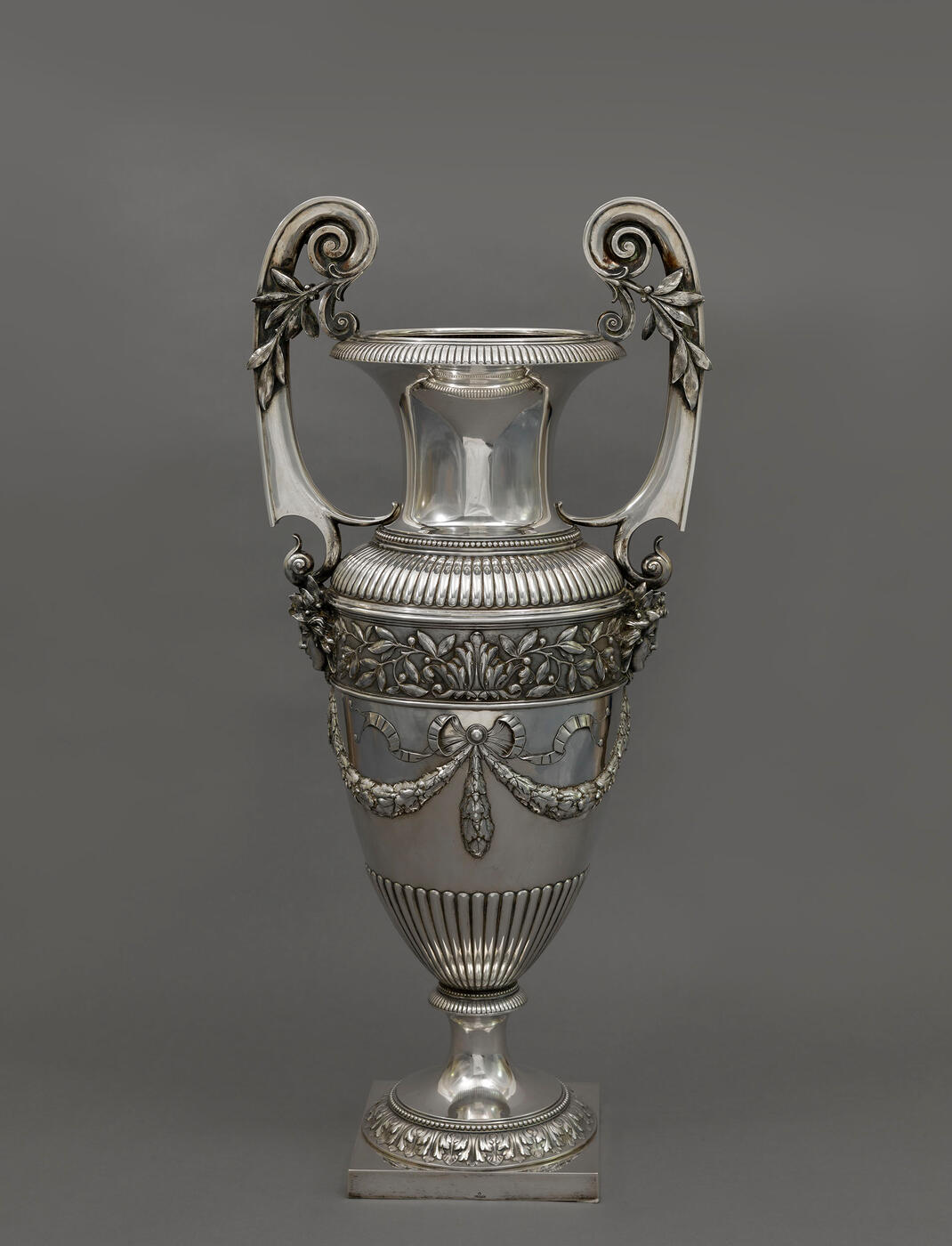MacDougall's Russian Art Auctions 27-30 May 2012
27 May 2012

405. A LARGE SILVER FABERGÉ VASE
MARK OF FABERGÉ UNDER IMPERIAL WARRANT, MARK PT FOR IMPORTED GOODS IN
CYRILLIC, MOSCOW, 84 STANDARD .
Height 87 cm, weight 9.2 kg.
150,000–200,000 GBP
Provenance: From the 1940s to the 1970s in the family of the Fabergé workmaster, Johan Viktor Aarne, Helsinki.
Private collection, Helsinki.
Private collection, Europe.
Authenticity certificate from the expert T. Muntyan.
Related literature: For similar marks and works, see Mir Fabergé (The World of Fabergé), Moscow-Vienna, 1992, cat. 139, p. 172.
A. N. Ivanov, “Preis-Kurant Torgovogo Doma D.P i M. Frolovy. Moskva, Ilyinka, Stary Gostiny Dvor, №9. Torgovlya Osnovana v 1788 godu. Moskva, 1900”, Neizvestnyi Fabergé (Unknown Fabergé), 2002, p. 99.
Of tapering baluster form with flared neck, the rim, upper and lower body gadrooned, upper section flanked by two cast, scroll-end
handles with olive sprigs, each handle rising from a cast classical mask, the middle section with collar of cast floral ornamentation above ribbon-tied laurel swags, foot with acanthus border on square socle.
The flower vase is an expressive and characteristic example of the late 19th century “historicist” style. The vase is a neoclassical piece, reflecting the prevailing taste of the cultural elite, which included the jeweller’s art. Neoclassicism assimilated not only artistic forms, but also a certain aristocratic aura from the art of its origins. This is vividly illustrated by the vase’s mounting which reflects Louis XVI forms and motifs in its design and is distinguished by its elegant ornamentation and representational qualities. The nature of the piece owes much to its meticulous design, fine proportions and masterly execution. These characteristics were evidently the reason why the Karl Fabergé’s firm imposed its own famous stamp upon the piece and sold it together with its own products. This was normal
procedure: for example, the pieces marked with a monogram “NV” which were sold by the Moscow branch of Fabergé. Apart from the wares of Russian masters, “K. Fabergé” also sold work by foreign jewellers and silversmiths
as the quality of these pieces was high enough for the Fabergé stamp to be put on them, examples of these works are now in Russia’s State museums. An example is the chased, silver photograph frame, stamped “K. Fabergé” and bearing and a pre-1899 Moscow assay hallmark for imported pieces (i.e., the letters “PT” in Cyrillic for “imported goods”) in the Moscow Kremlin Museums. The firm continued selling imported goods with its own stamp on them: for example, the finely executed biscuit dish in the form of a vine-leaf, also in
the Moscow Kremlin collection. The stamp on the present vase corresponds to that on the biscuit dish. Foreign goods were sold by other Russian firms, who also put their own stamp on them. Our significant and monumental
vase, possibly made in France, was apparently popular with Russian clientele. A piece of the same design was sold by the Trading House of D.P and M. Frolov in Moscow, which offered quite a number of silver works by foreign masters. In our opinion, the flower vase is of antiquarian and artistic significance to a collector.
Tatiana Muntyan, art historian
Notes on symbols:
* Indicates 5% Import Duty Charge applies.
Ω Indicates 20% Import Duty Charge applies.
§ Indicates Artist's Resale Right applies.
† Indicates Standard VAT scheme applies, and the rate of 20% VAT will be charged on both hammer price and premium.